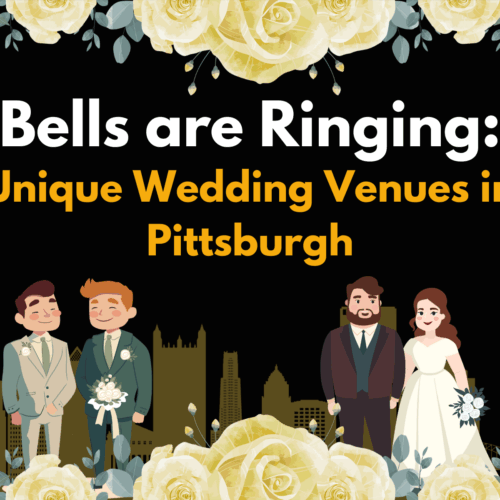
The Employee Retention Credit: What Business Owners Need to Know!
November 18, 2022
Pittsburgh: The City of Tunnels
December 18, 2022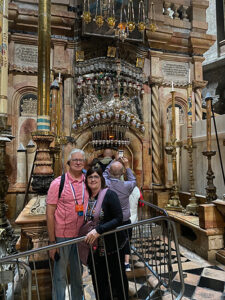 This fall, my husband and I along with 26 other Pittsburghers from Our Lady of Mt. Carmel parish in the North Hills, traveled to the Holy Land, visiting Israel and Jordan. I’ve traveled a bit, but not as much as some others in the group, including a couple who had just returned from three weeks of touring Botswana, and South Africa and already had a 74-day cruise around South America booked for January 2023.
This fall, my husband and I along with 26 other Pittsburghers from Our Lady of Mt. Carmel parish in the North Hills, traveled to the Holy Land, visiting Israel and Jordan. I’ve traveled a bit, but not as much as some others in the group, including a couple who had just returned from three weeks of touring Botswana, and South Africa and already had a 74-day cruise around South America booked for January 2023.
From the start, this trip was different from others I’d taken. When someone asked in the van shuttling us from the parking lot to the airport where we were heading , and I replied, Israel, the people said, Ooooh! Like we were moving up to the big leagues.
Initially, upon landing in Tel Aviv one of the most striking things about the Holy Land is the landscape. No wonder stoning was so popular there. A large part of Israel is composed of limestone; therefore, the mountainous landscape is littered with rocks and the buildings there are predominantly white as they are made of limestone. It was only when we went north to Galilee that the scenery changed. At one time a volcanic area, their rock formation was infused with basalt, making the rocks black and the buildings there of black stone. Israel has verdant valleys, lofty mountains, and desolate wilderness. It was astonishing to be in Jerusalem and then travel only a few miles and be in the Judean wilderness. It would be as if you left downtown Pittsburgh, went through the Liberty Tubes and came out the other side to barren dessert.
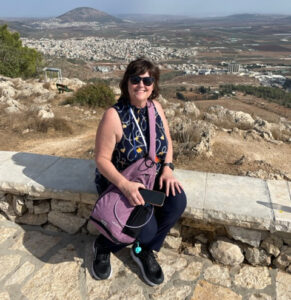 One of the other considerations was safety. We never once felt unsafe whether we were in the West Bank towns of Bethlehem or Nazareth, which are Muslim towns, or in Jewish Jerusalem. Our guide was a Roman Catholic born in Jerusalem, and Christians are less than 1% of the population in Israel. Our last day in Jerusalem, I got on the elevator with some people from Dallas, Texas, and one of the men asked if I had gone to the Western Wall that day. I said yes and he asked if we knew that someone was killed at the wall that morning. I said no. We’d been there in the afternoon. Apparently, someone had come to the Western Wall and was acting odd. When one of the soldiers questioned the man, he pulled a knife and was immediately shot. The traveler from Texas made a good point though. The night before was Halloween back home, and he said he saw on the news 14 people had been shot in Chicago alone. It’s all about perspective.
One of the other considerations was safety. We never once felt unsafe whether we were in the West Bank towns of Bethlehem or Nazareth, which are Muslim towns, or in Jewish Jerusalem. Our guide was a Roman Catholic born in Jerusalem, and Christians are less than 1% of the population in Israel. Our last day in Jerusalem, I got on the elevator with some people from Dallas, Texas, and one of the men asked if I had gone to the Western Wall that day. I said yes and he asked if we knew that someone was killed at the wall that morning. I said no. We’d been there in the afternoon. Apparently, someone had come to the Western Wall and was acting odd. When one of the soldiers questioned the man, he pulled a knife and was immediately shot. The traveler from Texas made a good point though. The night before was Halloween back home, and he said he saw on the news 14 people had been shot in Chicago alone. It’s all about perspective.
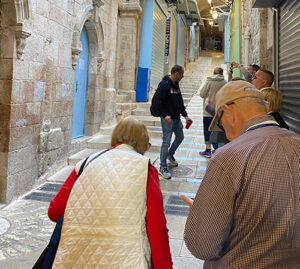
I was astounded at how many visitors were in Israel. COVID is over. Tourists were everywhere, and no one wore masks anywhere. We dined in our hotel for every breakfast and dinner and there were tour groups from the Philippines, Mexico, Germany, Canada, India, and Lebanon sharing the dining room with us.
As far as the culture, very few people were overweight, and we saw no one there with purple or blue hair. Many of the West Bank towns were impoverished, but the people took pride in their dress. No one was out on the street in sweatpants or pajama bottoms. Out in the desert, litter is everywhere. I don’t know if they don’t have garbage pickup there, but it seemed that no one cared about throwing trash out of the windows. Desolate roads winding through the desert areas of Jordan are cluttered with empty water bottles, plastic bags, and every kind of refuse imaginable. We joked that 2,000 years from now archeologists will uncover all these tossed water bottles and conclude that our world must have worshipped them because they are everywhere.
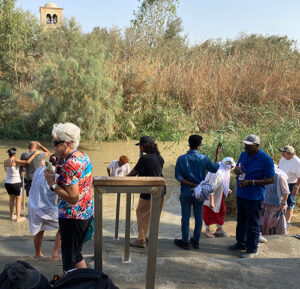
Whether Christian, Muslim or Jew, the people living in the Holy Land seemed to place a greater value on family life. On their Sabbath days, Jews shut down many of their establishments to spend the day in prayer and with family. On Muslim holy days, families like to gather for picnics. We saw some roll out rugs on the side of busy highways and grill food. Our guide seemed to know every other Catholic in Jerusalem, and our Christian guide, Hassan, in Jordan told us he had 56 first cousins, and I believed him. It seemed that everywhere we went, someone came up and kissed his cheek, and Hassan would say, “That’s a cousin.”
In the U.S., Freedom of Religion is guaranteed in our Constitution, but in Israel I saw and heard more overt displays of religious expression there than at home. We heard the Muslim call to prayer numerous times and saw men on the street praying on their prayer rugs. We saw Jews at the Western Wall inserting prayers into the cracks in the bricks and reading the Torah aloud. And we saw Christian groups praying in unison in restaurants and in front of Holy Sites on the streets.
Whether you are a believer in God or not, the Holy Land, and Jerusalem in particular, is a remarkable place. We sailed on the Sea of Galilee; floated in the Dead Sea; visited Qumran, where the Dead Sea Scrolls were found; rode camels in Jericho, the world’s oldest city; and watched people from around the world be baptized in the Jordan River.
One of the most amazing things was that all of those places you’ve heard of or read about are real places. I read somewhere that Jerusalem has been besieged 23 times, captured and recaptured 44 times. We visited sites meaningful to Christians and learned that Holy Sites soon after Jesus’s Resurrection began to be venerated by his followers. When the Romans destroyed Jerusalem shortly after His death, they erected Pagan temples over the Holy Sites, which ended up being fortuitous. When Rome fell, the Byzantines who came to the Holy Land knew where to find the Holy Sites, under the Pagan temples. They built churches over the sites, and they stood until they were either destroyed by earthquakes or by other invaders like the Persians or Ottomans. The Crusaders came and rebuilt things and on and on.
Religiously, two things stand out in my mind. The first is the Pit. In the 1800s, the British came and did a lot of archeological excavations, (think Indiana Jones) and they believe that they found Caiaphas’s palace and the dungeon or pit where Jesus was held before his interrogation and crucifixion. We descended into the pit, which was a hollowed-out cavern deep below the palace. There a member of our group read Psalm 88 which has lines such as “You plunge me into the bottom of the pit, into the darkness of the abyss. My only friend is darkness.”
There is electricity now in the Pit to accommodate visitors, but when Jesus would have been imprisoned there, it would have been cold and pitch-black. My only thought was if you’ve ever felt that you’ve been thrown into a pit in life, remember, that Jesus knows what that is like and can accompany you in the darkness.
The second happened in the Holy Sepulcher, the church built over Christ’s empty tomb. To avoid the large crowds that gather there, our guide took us to the tome early in the morning. One of the first things you see when you enter the church is the Stone of Anointing, the slab of stone where Jesus’s body lay after the crucifixion, as it was anointed for burial. It was powerful to witness people from all over the world from all races and in various modes of dress, come in, touch the stone, embrace the stone, kiss it, or weep over it.
Visiting where the history goes back approximately 5,000 years, it impresses upon you that our life on earth is just a heartbeat in time, and that power is fleeting. Kingdoms and rulers have fallen there from Babylonians to Persians to Romans to Ottomans; they have all fallen but the one enduring thing that has never left the Holy Land is God.
By Janice Lane Palko


